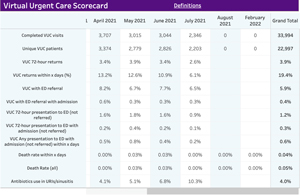In March 2020, as the COVID-19 pandemic took hold over the metro NYC area, NYU Langone Health saw a 683 percent increase in Virtual Urgent Care (VUC) video visits. Our clinicians saw an average of 20-30 patients per day virtually before the pandemic began, but that rose to over 1,000 per day at the height of COVID-19. Telemedicine’s growth has been incremental and relatively slow over the previous 5-10 years, but the current pandemic has created a need to quickly adapt to a new normal of social distancing and meet the increase in demand for virtual visits.
NYU Langone was well situated to meet this demand due to our existing infrastructure and strong foundation of digital tools, which we quickly scaled up to accommodate a higher capacity of patients. Our Virtual Urgent Care services began with just 40 physicians and has grown to include 289 providers from multiple specialties to treat patients during the pandemic. As telemedicine demand surged, we noticed an increase in not only the volume of patients, but also the type of patient that sought treatment from our providers. Through these services, our clinicians treat a wide range of patients from standard, low acuity patients to those who are acutely ill with multiple co-morbidities.


 Measuring clinical quality has been a standard process for in-person care for many years, but yet, has not been a major component of telemedicine-based care. National quality metrics for telemedicine were initially created by the National Quality Forum in 2017 to measure access, financial impact, effectiveness, and patient experience. Unfortunately, these metrics were not built to measure clinical quality of care.
Measuring clinical quality has been a standard process for in-person care for many years, but yet, has not been a major component of telemedicine-based care. National quality metrics for telemedicine were initially created by the National Quality Forum in 2017 to measure access, financial impact, effectiveness, and patient experience. Unfortunately, these metrics were not built to measure clinical quality of care.







